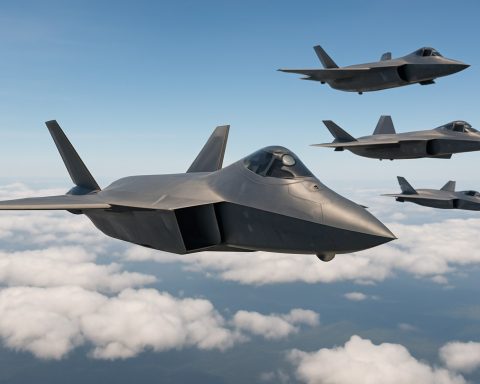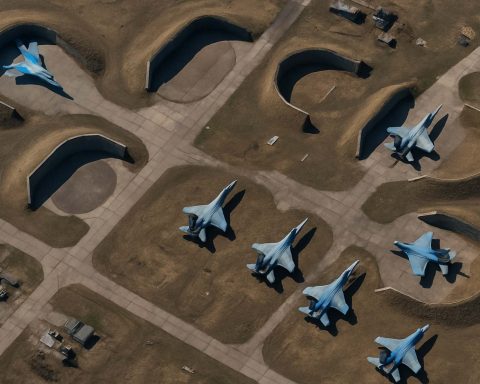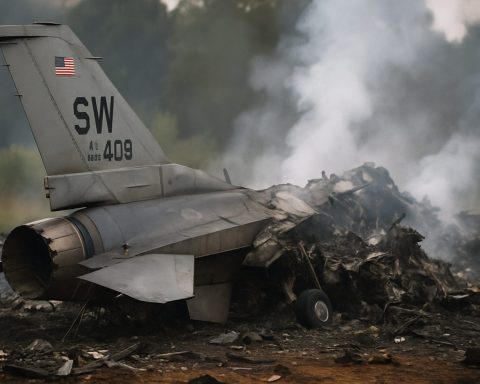- The F-47, a new fighter jet in America’s fleet, represents a critical shift in U.S. air dominance strategy.
- Awarded by the Trump administration to Boeing, the F-47’s development signifies a leap in technological ambition and military capability.
- Though promising advanced air combat prowess, the F-47 raises concerns about strategic priorities, especially when compared to existing models like the F-35.
- The high cost of development and production, juxtaposed with strategic budget constraints, poses a challenge to the Air Force.
- Congress plays a crucial role in balancing ambitions with fiscal responsibility and ensuring that the pursuit of air dominance doesn’t overshadow other defense priorities.
- The F-47’s story highlights the tension between innovation and practicality in contemporary military planning.
Imagine a fighter jet that can dominate the skies, slicing through the heavens with razor precision and cutting-edge technology. The F-47, a newly minted star in America’s air fleet, stands at the crossroads of ambition and controversy, awaiting takeoff amidst high-stakes strategic debates.
The Trump administration’s awarding of the contract to Boeing for the Next Generation Air Dominance fighter, or F-47, signals a monumental step for U.S. military capabilities, yet it raises pressing questions about priorities and strategy. What appears on the surface as a bold move for technological superiority demands a closer look at its implications for the future of defense.
The journey of the F-47 began with the Aerospace Innovation Initiative in 2015, under the visionary leadership of an eager defense sector. The initiative birthed experimental X-planes, promising daring technological leaps beyond the capabilities of the reigning F-35. Today, this program shoulders the legacy of relentless innovation, powering the F-47 to life.
However, the path to progress is littered with cautionary signs. The Air Force’s pivot from the tried-and-true F-22 to the F-47’s Penetrating Counter Air missions signifies a shift toward daring operations deep within enemy territory. While these missions showcase audacity, they come with staggering costs—tens of billions in development and millions per aircraft in production. With a modest fleet of fewer than 200 F-22s, each airplane is precious, and the margin for loss is slim.
The real battleground lies in the strategy that underpins this significant investment. In an era where nuclear powers like China and Russia loom large, the question begs: Is this the right aircraft for an evolving defense matrix? Could a focus on Defensive Counter-Air missions, favoring affordability and versatility, prove wiser in an uncertain future? The comparison with the multirole F-35 and the rising ethos of uncrewed tactical coordination brings fresh perspectives to the debate.
Moreover, as the Trump administration charts its defense course, the looming budgetary clouds cannot be ignored. The F-47’s appendage of tens of billions in additional funding might strain an already stretched Air Force budget—one that must juggle the critical imperative of modernizing the nuclear triad alongside other strategic fiascos.
The critical eye of Congress is a beam of accountability in this intersection of ambition and fiscal reality. The questions extend beyond simple costs to encompass strategic priorities. The grandeur of the F-47 should not overshadow urgent needs, like counter-space weapons and airbase defenses, both pivotal in safeguarding against escalating global threats.
In essence, the tale of the F-47 teeters between triumphant leap and costly misstep, demanding scrutiny and foresight. As the sky beckons this formidable jet, Congress must ensure the journey toward U.S. air dominance does not eclipse more pressing priorities. In the theater of lawmaking and strategy, the story of the F-47 is not just about soaring innovations but also about the grounding wisdom needed for sustainable defense.
Is the F-47 the Future of Air Dominance or a Strategic Misstep?
Introduction
The F-47, often touted as the next frontier in air combat technology, represents a significant leap in military capabilities. Awarded to Boeing under the Trump administration, the F-47’s development is part of the Next Generation Air Dominance (NGAD) program, aiming to revolutionize U.S. military air power. However, this ambitious project raises various strategic, financial, and ethical considerations around its role in modern defense.
Key Features and Specifications
The F-47 is positioned as a groundbreaking fighter jet within the U.S. military’s arsenal.
– Advanced Pentrating Counter Air Missions: Designed to perform complex operations deep within enemy lines, showcasing unprecedented levels of stealth and agility.
– Cutting-edge Technology: Integrates next-generation avionics, stealth capabilities, and potentially artificial intelligence-driven flight systems.
– Production and Cost: Expected to see high production costs, with each aircraft potentially running millions per unit. This indicates the high investment needed for development and deployment.
The Strategic Debate
Are Air Defense Missions the Future?
One of the central questions is whether the F-47’s penetrating focus is prudent in today’s geopolitical climate, especially given the threats posed by nuclear actors like China and Russia. Instead, some argue for prioritizing Defensive Counter-Air missions, which could offer more flexibility and cost-effectiveness.
– Pros: High capabilities for offensive operations could deter major power conflicts.
– Cons: Immense cost implications could derail other crucial defense initiatives, such as counter-Space weapons.
The Budgetary Implications
The F-47 program demands substantial financial commitments, which may challenge the Air Force’s broader budgetary framework. As Congress scrutinizes defense expenditures, the multi-billion dollar investment raises questions:
– Nuclear Modernization: Balancing aircraft programs against the pressing necessity to update the nuclear triad.
– Other Priorities: Potential underfunding of other strategic areas like cyber warfare and airbase defenses.
Industry Trends and Predictions
Unmanned Aerial Systems (UAS)
The rise of unmanned tactical systems might revolutionize air defense strategies, offering a cheaper and scalable alternative to manned fighters like the F-47. The integration of UAS with traditional air systems could define future military engagements.
Market Trends
The defense aviation sector is seeing an increased focus on collaborative unmanned and manned systems, stealth technology, and AI integration. The F-47 is at the forefront of these advancements.
Real-World Use Cases
– Enhanced Stealth Operations: The F-47’s stealth capabilities could provide reconnaissance and strategic penetration into hostile zones.
– Tech Integration: Potential to act as a central node in a networked defense grid involving drones, satellites, and ground control.
Challenges and Limitations
– High Costs: The development and maintenance of the F-47 could strain financial resources.
– Risk of Overemphasis: Focusing extensively on one technology may neglect other critical defense areas.
Pros and Cons Overview
Pros
– Superior technological capabilities.
– Potential for high strategic impact in complex missions.
Cons
– Significant financial burden.
– Strategic risk if it overshadows other defense needs.
Conclusion and Recommendations
For military strategists and policymakers, it is crucial to weigh the F-47’s merits against its costs carefully. Ensuring a balanced defense strategy that also emphasizes cybersecurity, drone technologies, and nuclear deterrence will be essential for long-term security.
Quick Tips:
– Budgeting Consideration: Diversify investments across different defense sectors to ensure a balanced approach.
– Strategic Inquiry: Regular evaluations of emerging threats and adjusting defense priorities are necessary.
For more about evolving defense technologies and strategic defense innovations, visit Boeing.









